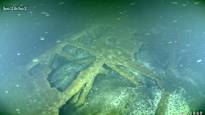Kaleva took his last flight in 1940 from Tallinn. The wreckage of the plane was found at the beginning of June after decades of searching.
TALLINN Finnish airline Aero’s passenger plane Kaleva took off on June 14, 1940. The Soviet Union had just blockaded Estonia from sea and air as part of preparations for the upcoming occupation.
Shortly after takeoff, at two o’clock in the afternoon, two Soviet bombers appeared next to Kaleva. They opened machine gun fire and dropped the passenger plane into the Gulf of Finland.
The captain of the plane Bo Hermansson von Willebrand and the radio operator Tauno Launis and seven passengers died.
After that, a Soviet submarine appeared on the scene. Its crew seized the objects and diplomatic mail they collected from the surface of the water, threatening them with guns.
– Kaleva was one of the last flights out of Estonia. After that, the world closed in on Estonia, Kaido Peremees says 84 years later.
Estonia surrendered to the Soviet occupiers before the then president Konstantin Pätsin by decision without armed resistance. Fifty years of occupation and oppression followed.
See also: Ylen’s Living Archive: The destruction of passenger plane Kaleva was kept silent for decades
Immediately after the shooting down, neither Finland nor Estonia protested what happened in any way. Finland, which had survived the Winter War, was in a delicate truce phase, and Soviet troops marched into Tallinn three days later.
In contemporary news, the plane’s crash was presented as an accident, even though there were Estonian eyewitnesses.
In this video, diving entrepreneur Kalev Peremees tells about the discovery of the Kaleva wreck:
The fate of the Kaleva wreck has been considered and searched for decades. It was often assumed that the Soviets raised the wreckage shortly after the shooting down.
The diving entrepreneur, who has cooperated with the Estonian Maritime Museum for a long time, says that the development of technology and a few other successful projects brought the itch that finding Kalevanki could be tried again.
– I went through all the information and old maps. Based on the coordinates of the Russian submarine, they then began to go through the area from north to south, says Kaido Peremees.
– And that was it! The wing was the first to be seen in the sonar image. It was a completely undisputed target.
According to Peremees, the wreckage was clearly identifiable as a Junkers 52 plane from the images of the diving robot. This is evidenced by, among other things, the wavy surface of the wing, which is characteristic of the machine type. In addition, the pictures showed the large size, shape, landing gear and ring of the wing.
Aero’s missing Kaleva was a three-engine Junkers Ju 52/3m.
– For a couple of seconds I felt like a world champion, Peremees laughs.
According to him, the probability that another Junkers 52/3m would have fallen in the same place is practically non-existent.
– The location of the wreck matches the witnesses’ accounts to within 500 meters. At sea, it’s a non-existent distance, says Kaido Peremees.
The shooting down of Kaleva was never investigated and its cause was never found out. Over the years, the shooting has been connected, among other things, to the meticulous monitoring of the Soviet Union’s blockade of Estonia and the diplomatic mail that was in the plane’s cargo.
The future of the parts of Kaleva, resting at a depth of more than 70 meters at the bottom of the Gulf of Finland, is now in the hands of the Estonian Museum Agency and why not also the Finnish Aviation Museum, says Kaido Peremees.
He wonders if the discovery can even be interpreted as evidence.
– However, it is a crime scene.
What thoughts did the discovery of the wreckage of the passenger plane Kaleva evoke?
